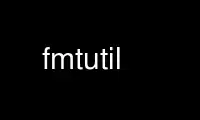
This is the command fmtutil that can be run in the OnWorks free hosting provider using one of our multiple free online workstations such as Ubuntu Online, Fedora Online, Windows online emulator or MAC OS online emulator
PROGRAM:
NAME
fmtutil - manage TeX formats, Metafont bases and Metapost mems, per-user
fmtutil-sys - manage TeX formats, Metafont bases and Metapost mems, system-wide
mktexfmt - create a TeX format, Metafont base, or Metapost mem
SYNOPSIS
fmtutil [OPTION] ... [COMMAND]
fmtutil-sys [OPTION] ... [COMMAND]
mktexfmt FORMAT.fmt|BASE.base|MEM.mem|FMTNAME.EXT
DESCRIPTION
fmtutil version svn36788 (2015-04-13 00:53:26 +0900)
Rebuild and manage TeX formats, Metafont bases and MetaPost mems.
If the command name ends in mktexfmt, only one format can be created. The only options
supported are --help and --version, and the command line must consist of either a format
name, with its extension, or a plain name that is passed as the argument to --byfmt (see
below). The full name of the generated file (if any) is written to stdout, and nothing
else.
If not operating in mktexfmt mode, the command line can be more general, and multiple
formats can be generated, as follows.
OPTIONS
--cnffile FILE
read FILE instead of fmtutil.cnf (can be given multiple times, in which case all
the files are used)
--fmtdir DIRECTORY
--no-engine-subdir
don't use engine-specific subdir of the fmtdir
--no-error-if-no-format
exit successfully if no format is selected
--no-error-if-no-engine=ENGINE1,ENGINE2,...
exit successfully even if the required engine
is missing, if it is included in the list.
--quiet
be silent
--test (not implemented, just for compatibility)
--dolinks
(not implemented, just for compatibility)
--force
(not implemented, just for compatibility)
Commands:
--all recreate all format files
--missing
create all missing format files
--refresh
recreate only existing format files
--byengine ENGINENAME
(re)create formats using ENGINENAME
--byfmt FORMATNAME
(re)create format for FORMATNAME
--byhyphen HYPHENFILE
(re)create formats that depend on HYPHENFILE
--enablefmt FORMATNAME
enable formatname in config file
--disablefmt FORMATNAME
disable formatname in config file
--listcfg
list (enabled and disabled) configurations, filtered to available formats
--catcfg
output the content of the config file
--showhyphen FORMATNAME
print name of hyphenfile for format FORMATNAME
--version
show version information and exit
--help show this message and exit
ENVIRONMENT
Explanation of trees and files normally used:
If --cnffile is specified on the command line (possibly multiple times), its
value(s) are used. Otherwise, fmtutil reads all the fmtutil.cnf files found by
running `kpsewhich -all fmtutil.cnf', in the order returned by kpsewhich.
In any case, if multiple fmtutil.cnf files are found, all the format definitions
found in all the fmtutil.cnf files are merged.
Thus, if fmtutil.cnf files are present in all trees, and the default layout is used
as shipped with TeX Live, the following files are read, in the given order.
For fmtutil-sys:
TEXMFSYSCONFIG $TEXLIVE/YYYY/texmf-config/web2c/fmtutil.cnf
TEXMFSYSVAR $TEXLIVE/YYYY/texmf-var/web2c/fmtutil.cnf
TEXMFLOCAL $TEXLIVE/texmf-local/web2c/fmtutil.cnf
TEXMFDIST $TEXLIVE/YYYY/texmf-dist/web2c/fmtutil.cnf
For fmtutil:
TEXMFCONFIG $HOME/.texliveYYYY/texmf-config/web2c/fmtutil.cnf
TEXMFVAR $HOME/.texliveYYYY/texmf-var/web2c/fmtutil.cnf
TEXMFHOME $HOME/texmf/web2c/fmtutil.cnf
TEXMFSYSCONFIG $TEXLIVE/YYYY/texmf-config/web2c/fmtutil.cnf
TEXMFSYSVAR $TEXLIVE/YYYY/texmf-var/web2c/fmtutil.cnf
TEXMFLOCAL $TEXLIVE/texmf-local/web2c/fmtutil.cnf
TEXMFDIST $TEXLIVE/YYYY/texmf-dist/web2c/fmtutil.cnf
(where YYYY is the TeX Live release version).
According to the actions, fmtutil might write to one of the given files or create a
new fmtutil.cnf, described further below.
Where changes are saved:
If config files are given on the command line, then the first one given will be
used to save any changes from --enable or --disable. If the config files are taken
from kpsewhich output, then the algorithm is more complex:
1) If $TEXMFCONFIG/web2c/fmtutil.cnf or $TEXMFHOME/web2c/fmtutil.cnf appears in the
list of used files, then the one listed first by kpsewhich --all (equivalently, the
one returned by kpsewhich fmtutil.cnf), is used.
2) If neither of the above two are present and changes are made, a new config file
is created in $TEXMFCONFIG/web2c/fmtutil.cnf.
In general, the idea is that if a given config file is not writable, a higher-level
one can be used. That way, the distribution's settings can be overridden for
system-wide using TEXMFLOCAL, and then system settings can be overridden again for
a particular using using TEXMFHOME.
Resolving multiple definitions of a format:
If a format is defined in more than one config file, then the definition coming
from the first-listed fmtutil.cnf is used.
Disabling formats:
fmtutil.cnf files with higher priority (listed earlier) can disable formats
mentioned in lower priority (listed later) fmtutil.cnf files by writing, e.g.,
#! <fmtname> <enginename> <hyphen> <args>
in the higher-priority fmtutil.cnf file.
As an example, suppose you have want to disable the luajitlatex format. You can
create the file $TEXMFCONFIG/web2c/fmtutil.cnf with the content
#! luajitlatex luajittex language.dat,language.dat.lua lualatex.ini
and call fmtutil.
fmtutil vs. fmtutil-sys (fmtutil --sys):
When fmtutil-sys is run or the command line option --sys is used, TEXMFSYSCONFIG
and TEXMFSYSVAR are used instead of TEXMFCONFIG and TEXMFVAR, respectively. This
is the primary difference between fmtutil-sys and fmtutil.
Other locations may be used if you give them on the command line, or these trees
don't exist, or you are not using the original TeX Live.
REPORTING BUGS
Report bugs to: [email protected]
TeX Live home page: <http://tug.org/texlive/>
Use fmtutil online using onworks.net services
